You can’t swing a dead cat around the survivalist internet sites without running into thousands, no, hundreds of thousands of 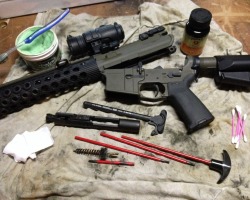 gun-related articles. Most deal with variations on a theme: 9mm vs. 45 ACP or AR-15 vs. AK-47. Not quite so common but still prevalent are articles that focus on training skills to acquire. However, I find it hard to find dedicated articles that focus on repair skills that will surely be needed after firearms are used daily over an extended period of time.
gun-related articles. Most deal with variations on a theme: 9mm vs. 45 ACP or AR-15 vs. AK-47. Not quite so common but still prevalent are articles that focus on training skills to acquire. However, I find it hard to find dedicated articles that focus on repair skills that will surely be needed after firearms are used daily over an extended period of time.
By Drew, a contributing author of SHTFBlog & Survival Cache
Where To Begin?
Granted, it’s difficult to make these very specific, since everyone likes a different platform, and trying to cover “how to fix any gun” is like trying to write an article on “how to fix any car”. It just can’t be done, and it’s one of the reasons I try to tell people to consolidate platforms (especially if you are part of a planned SHTF team), and to take armorer’s courses on the platforms that are mainstays of the team or the individual. I know many people that have scores of guns that each has its own individual place in “the plan”, but the bare, simple truth is this: you have two hands and your belt and back, and you can’t take ‘em all with you out the door.
Sorry, folks. It’s fine to have hundreds of guns (we encourage it, actually!) but for the ones that you’ll have with you without fail when you bug out the door, you NEED to have a personal, intricate knowledge of how they work. That YouTube video that helped you fully disassemble your SKS so you can install a folding stock probably ain’t gonna be available when you’re lining up a shot on a nice plump deer to feed the crew and the gun goes “click” with a gummed-up firing pin. Know what you have. Know what you’ll take. Know how to fix it. Yes, $300 for an armorer’s course may seem pricey, but how much did you spend on extra magazines and ammo last year? This is just as important.
So you know that guns “X” and “Y” will be bugging out the door with you, you’ve got all the magazines and ammo you need for them, and you’ve taken an armorer’s course. Awesome! You’re head and shoulders above most people out there but do you have the tools to fix these guns? Do you know how they work? Do you have spare parts for your guns in case they wear or break? (keep in mind most firearms manufacturers recommend spring, extractor, and/or ejector replacements after 5,000 rounds!) A comprehensive dedicated armorer’s kit is worth its weight in gold, and here are a few things that you shouldn’t be without in your firearms maintenance plan.
To put things in perspective: in my mind, an armorer’s kit is not a kit that goes everywhere with you: this stays where you will have a safe, calm, well-lit environment where you can work on your firearms with no pressures. A small basic in-field maintenance kit should go everywhere with your guns (look at some of the gun-specific kits from Otis as a good starting point for a bug-out cleaning kit), but the armorer’s kit will probably be too bulky to take with you all over hell’s half acre.
10 Items You Need
#1: Heavy-duty storage container(s): You’re going to need a place to keep all this gear and spare parts safe and organized. 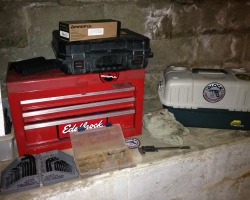 I used to use fishing tackle boxes… that worked pretty well for a while, and it’s a good place to start. They have lots of customizable drawers and compartments that fold out, and they’re portable, with built-in handles. The problem is, over time, you accumulate stuff. You’ll work on guns, and as you replace parts, upgrade, or keep spares, the tackle box just doesn’t hold it all anymore. The pull-out shelves pop out from their pivot points. The latches break. They simply aren’t rugged enough to be stuffed with stuff, in my experience. I still keep a tackle box with basic goodies in it for trips to the range, or working on a gun at a buddy’s house, but for serious work, we need serious storage.
I used to use fishing tackle boxes… that worked pretty well for a while, and it’s a good place to start. They have lots of customizable drawers and compartments that fold out, and they’re portable, with built-in handles. The problem is, over time, you accumulate stuff. You’ll work on guns, and as you replace parts, upgrade, or keep spares, the tackle box just doesn’t hold it all anymore. The pull-out shelves pop out from their pivot points. The latches break. They simply aren’t rugged enough to be stuffed with stuff, in my experience. I still keep a tackle box with basic goodies in it for trips to the range, or working on a gun at a buddy’s house, but for serious work, we need serious storage.
I’ve since upgraded to a Sears Craftsman steel tool chest. Yes, it’s heavy. Yes, it’s big. But the construction is no-nonsense, and it holds all my various tools and accoutrements in order, with room to spare. I use plastic tray inserts to hold all the small parts, like bore brushes and jags, to keep them from rolling around and having to hunt for them. I use emptied pill bottles to hold used extra or replaced screws and pins (a godsend when you drop a small screw on the floor and it rolls into a heating vent. Been there, done that.). Specialized gun-specific tools can go in one drawer, basic tools can go in another, and patches, rags, and other gun-related “stuff” can go in its own drawer. I’ve learned that bottles of solvents and oils can’t be left on their sides in a drawer, as they tend to leak, despite the best of intentions. So I usually get a snap-top Tupperware or Rubbermaid container for these goods. The snap-top containers work well for loose items, like old removed sights, scope bases, sling swivels, and other items that seems to just build up on me. Also, they can house gun-specific spare parts so you don’t need to go searching for one part for one gun: it’s in its own container.
If you’re just building an armorer’s kit for just, say, your AR-15 and your Glock, you probably won’t need such a big setup. I work on lots of people’s guns, so eventually I realized I needed to go this big. You’ll have to scrutinize your own setup and prepare accordingly.
#2: Firearm-Specific Armorer’s Manuals: If you haven’t taken an armorer’s course, these will help you figure out your gun…they just won’t be there to lend a hand first time around like an instructor will. If you HAVE taken a course, these are valuable back-ups to have in case you’re working on your gun and you just draw a blank on what the next step is, or how one assembly goes back together. I can’t tell you how many times I’ve gone back to my dog-eared manuals to go, “ohhh yeaaahhhhh…”. Several companies make good gun-specific manuals: the American Gunsmithing Instituite offers manuals, DVDs, and tool kits for MANY specific firearms. I don’t own any so I can’t vouch for the quality, but it’s a definite step in the right direction. If you have a US military issued firearm, they have Military Technical Manuals (like this one for the M16/M4 platform) that will tell you everything you need to know. It’s cheap, reliable knowledge for when the YouTubes videos are no longer there.
#3: Firearm-Specific Tools: There are basic tools that you’ll use all the time when working on firearms (more on that next) 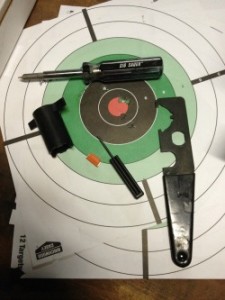 but when (for example) you need to get the barrel nut off an AR-15, only the correct wrench will work. You can sometimes adapt other tools to work, but they never work as well as the specifically designed tool. When you take Glock armorer’s courses,they give you the punch and inspection plate that you’ll need, and that’s pretty damn cool. Other companies/makes require a few specialized tools (see the AR-15 example above) and you’ll usually have to buy them. However, it’s always well worth the money. The Sig Sauer combination tool I have is amazing for working on my Sigs, even though it ran me $45. In the case of platforms where there is a LOT of aftermarket tool supply, try to shy away from the cheapo tools: if it looks to good to be true, it is.
but when (for example) you need to get the barrel nut off an AR-15, only the correct wrench will work. You can sometimes adapt other tools to work, but they never work as well as the specifically designed tool. When you take Glock armorer’s courses,they give you the punch and inspection plate that you’ll need, and that’s pretty damn cool. Other companies/makes require a few specialized tools (see the AR-15 example above) and you’ll usually have to buy them. However, it’s always well worth the money. The Sig Sauer combination tool I have is amazing for working on my Sigs, even though it ran me $45. In the case of platforms where there is a LOT of aftermarket tool supply, try to shy away from the cheapo tools: if it looks to good to be true, it is.
#4: High-Quality Punch And Drift Set: Punches are used almost universally in every gun out there, to push pins out of guns, push sights out of dovetails, or slave parts together for re-assembly. An assortment of sizes, in both brass and steel, will be essential. Brass, being softer than steel, generally does not deform, dent, or mar steel parts. However, it WILL mar finishes, which isn’t the end of the earth. Brass punches will deform over time, mushrooming out where they are impacted with hammers. The stems of them can also bend in the smaller-diameters. Steel drifts are obviously tougher, and you use them to push out straight pins and roll pins from the receivers of firearms. Get hardened machined steel punches – Brownell’s and Midway USA carry good ones that are made for the gunsmith. However, being hardened steel, they are far more brittle than their brass counterparts, and they will snap and shatter. Buy a few extras in the smaller sizes (1/16”, 3/32”, and 1/8”…I’ve busted many of these sizes, especially on the rusted-up guns. Keep a set of safety glasses on in case they shatter.
#5: Bench Block: A bench block is a plastic or wood block with holes drilled in it and valleys inset so you can work on your 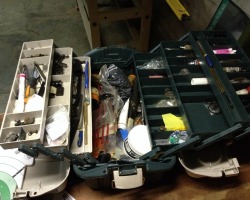 guns and hold them steady, while preventing harm to surfaces below. Many the time has been that I’ve started drifting a pin out of a gun to realize that the pin has come out of the other side of the gun and burrowed its way into the kitchen table. You feel stupid and draw the rapid, vicious ire of the wife. If I had set the part on the bench block, with the pin coming out and into one of the holes in the block, I may have saved myself a hung head and a tube of wood putty. A bench block also has valleys you can lay a barrel of a gun into to keep it from rolling around as you work on it. You can make your own with a bit of ingenuity, a drill, and a block of scrap wood, or you can buy your own like this one by Wheeler.
guns and hold them steady, while preventing harm to surfaces below. Many the time has been that I’ve started drifting a pin out of a gun to realize that the pin has come out of the other side of the gun and burrowed its way into the kitchen table. You feel stupid and draw the rapid, vicious ire of the wife. If I had set the part on the bench block, with the pin coming out and into one of the holes in the block, I may have saved myself a hung head and a tube of wood putty. A bench block also has valleys you can lay a barrel of a gun into to keep it from rolling around as you work on it. You can make your own with a bit of ingenuity, a drill, and a block of scrap wood, or you can buy your own like this one by Wheeler.
#6: Dedicated Gunsmithing Screwdriver Set: I’ll admit it, I am the HUGEST stickler for proper gunsmithing screwdrivers. Gun screws are generally finely machined items, with a precise slot milled into it. A proper gunsmithing screwdriver will be hollow-ground as opposed to a tapered point, like usual flat-head screwdrivers usually do. Check out this thread in a forum where the difference is shown nicely. A properly fitting hollow-ground screwdriver fills the slot in the screw completely, and ensures that maximum torque can be applied without the screwdriver slipping and buggering the head of the screw. If the balloon goes up and the only screws that you’ll have hope of finding for your gun are the ones IN your gun, you’re going to want to make damn sure that they never strip out. The correct screwdriver helps you ensure this doesn’t happen.
#7: Allen/Torx Wrench Index Set: More and more manufacturers, especially in the “tactical” arena, are ditching the 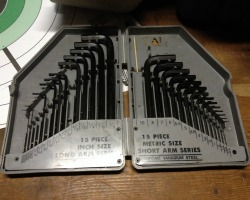 traditional flathead screw and using torx and/or allen head screws. Personally, I favor the flathead or even phillips head screws over the allen head (ever stripped an allen head screw? Get out the drill!) but we have to be prepared, no matter what the personal bias may be. I prefer indexes of many different separate “L” shaped wrenchesover the all-in-one folding-type setups, but to each his own. I’ve been known to use an allen wrench as a pin punch in a pinch (say THAT ten times fast.).
traditional flathead screw and using torx and/or allen head screws. Personally, I favor the flathead or even phillips head screws over the allen head (ever stripped an allen head screw? Get out the drill!) but we have to be prepared, no matter what the personal bias may be. I prefer indexes of many different separate “L” shaped wrenchesover the all-in-one folding-type setups, but to each his own. I’ve been known to use an allen wrench as a pin punch in a pinch (say THAT ten times fast.).
#8: Hammers and Mallets: We will need impact implements of a couple kinds when working on our guns. I run with a couple: a good kick-ass ball peen hammer (Estwing all the way on this bad boy and they didn’t even pay me to say that…Estwing hammers just rock) to use on drifts and punches when tapping out pins, as well as general mayhem as needed. A brass mallet is invaluable for starting small pieces like sights in dovetails, and for light-duty impact use. A double-headed plastic and rubber mallet will be wonderful for light tapping of parts that are a bit stubborn, but that you don’t want scarred or marred. It will also work well seating and tapping parts just a small amount to get them properly aligned. This is one of the classes of tools that will prove to be useful around the house as well…just resist the temptation or be sure to put it back when you’re done. Having the proper hammer to do a job when you’re working on firearms is a godsend.
#9: Cleaning Tools: This is pretty simple, but varied according to your own personal taste and experience. I like steel 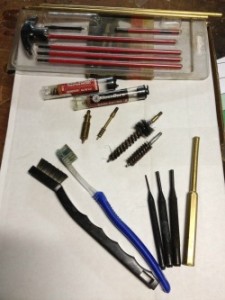 cleaning rods (one-piece if possible for rifles) with bore guides for cleaning my bores, but brass rods work pretty well too and won’t beat up the bore as badly. They do snap, however. And forget those miserable aluminum Wal-mart cleaning kits: They suck. There, I said it. They will warp, bend, snap, and leave you feeling generally empty inside as well as leaving you open for ridicule from your gun buddies. Man up and buy a good cleaning rod that will last forever. I like brass cleaning patch holders to hold my patches – I shy away from the plastic ones: they always seem to bend on me. For bore brushes, I really like the Kleenbore brand brushes, as they come in their own plastic tubes and it helps keep things organized, especially when you have lots of calibers to tend to. I use stainless steel bore brushes for busting up heavily fouled bores and with use with rugged solvents (that would melt bronze brushes over time), and I use bronze bore brushes for general cleaning. I always have used toothbrushes from household use kicking around for scrubbing dirty guns, and keep purpose-made gun cleaning brushes handy too, for various purposes. I’ll buy big lots of pre-made gun cleaning patches when I find them cheap; however, I’ll be just as happy to cut up old T-shirts as well. Dental picks, toothpicks, and LOTS of Q-tip swabsare always welcome here too.
cleaning rods (one-piece if possible for rifles) with bore guides for cleaning my bores, but brass rods work pretty well too and won’t beat up the bore as badly. They do snap, however. And forget those miserable aluminum Wal-mart cleaning kits: They suck. There, I said it. They will warp, bend, snap, and leave you feeling generally empty inside as well as leaving you open for ridicule from your gun buddies. Man up and buy a good cleaning rod that will last forever. I like brass cleaning patch holders to hold my patches – I shy away from the plastic ones: they always seem to bend on me. For bore brushes, I really like the Kleenbore brand brushes, as they come in their own plastic tubes and it helps keep things organized, especially when you have lots of calibers to tend to. I use stainless steel bore brushes for busting up heavily fouled bores and with use with rugged solvents (that would melt bronze brushes over time), and I use bronze bore brushes for general cleaning. I always have used toothbrushes from household use kicking around for scrubbing dirty guns, and keep purpose-made gun cleaning brushes handy too, for various purposes. I’ll buy big lots of pre-made gun cleaning patches when I find them cheap; however, I’ll be just as happy to cut up old T-shirts as well. Dental picks, toothpicks, and LOTS of Q-tip swabsare always welcome here too.
#10: Oils, Lubes, Solvents: I have lots of these kicking around. Mostly because when I’m doing work on my guns, I’m not an 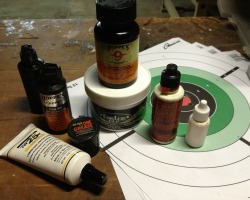 all-in-one CLP (Cleaner, Lubricant, Preservative) guy. Do I use CLP in my field kit? Hell yes! It does an OK enough job at those duties that it’s a good way to save space when you have to be mobile but still want to care for your gun. However, when I have the time to break down my guns, I use the right product for the job. There are literally THOUSANDS of products out there: do your research, try them out yourself; these are highly personal choices.
all-in-one CLP (Cleaner, Lubricant, Preservative) guy. Do I use CLP in my field kit? Hell yes! It does an OK enough job at those duties that it’s a good way to save space when you have to be mobile but still want to care for your gun. However, when I have the time to break down my guns, I use the right product for the job. There are literally THOUSANDS of products out there: do your research, try them out yourself; these are highly personal choices.
Here’s What I Like:
Solvents: Solvents are used to chemically break down carbon, lead, and copper deposits and loosen them up so they can be scrubbed free. I’m an unabashed Hoppes #9 fan boy for this category. Hoppes has been around forever, and probably will be around forever. It’s inexpensive, it works, and you can buy it in large quantities. It stores well, too. An honorable mention goes out to Shooter’s Choice for this line of work: it works as well, maybe even a bit better than Hoppes, but it’s pricier.
Lubricants: Lubricants are broken down into two categories in my mind: oils and greases. I use oils on parts like bolt bodies, slide and frame rails, springs, and pins; parts where there will be sliding motions, back-and-forth operations. It will keep parts from binding, grinding, and keeping friction temperatures down, as well as wicking away moisture and carbon buildup. Oils also work very well for short-term to medium-term rust prevention under most circumstances. I use greases on parts where there is actual shear force, or direct metal-on-metal interaction, like trigger and hammer mating surfaces, sears, disconnectors, etc. Greases can ease trigger pulls, and keep these parts sliding smoothly off each other. However, greases, by their makeup and nature, can gel up and increase viscosity much more drastically than oils in cold temperatures, so keep that in mind if you are in colder climes. For oils, I’ve been using FrogLube, Militec 1,and Hoppes Elite. However, I’ve been hearing awesome stuff about the new Liberty Lube line of products – we’ll have a review coming soon. For grease, I’ve found that Mill Comm TWB-25 (the same grease they supply with all new Sig Sauer pistols) is really phenomenal. I bought a 4 oz. tube a couple years ago and it’s lasted forever.
Preservatives: Preservatives are meant for long-term storage of the firearm and heavy protection from the elements. I also use them in areas that won’t see much attention in every-day cleanings, but may have water penetration: the areas between rifle stocks and barrels/actions, under scope mounts and sight bases. Preservatives, such as the ever-popular and (if you’re trying to clean it off) maligned Cosmoline, fully encapsulate the firearm and make it almost impervious to most elements. For long-term storage and preservation of “safe queen” collectible firearms, I’ve used RIG (Rust Inhibiting Grease) with wonderful success. Preservatives are generally much thicker than oils, and should be used when maximum protection is needed. In my opinion, the “preservative” part of CLPs should be more along the lines of “preventative” when it comes to the protection of firearms. For instance, if I was burying a firearm, I sure as hell wouldn’t just coat it in Break-Free CLP and call it good. A word to the wise, though: preservatives can solidify and cake up over time, and require heavy-duty solvents (even gasoline or Easy-Off Oven cleaner, in the case of Cosmoline) to remove fully. Plan accordingly.
There Is More
There are many other things that could go in a generic (non gun-specific) armorer’s kit, like a ratchet and socket set with extensions for removing stock bolts, etc., but they wouldn’t be used very frequently. As you work on your firearms more frequently, and as you see how they work and dive into other makes and models other than your dedicated SHTF platforms, you may decide to branch out and purchase things as you see fit. Items such as a bench-mounted vise with non-marring jaw pads(special vise blocks that are made for specific guns are available), a jeweler’s screwdriver set, a fine file set, channel locks, needle-nosed pliers, a hacksaw and a couple sizes of vice-grips can help quite a bit for when you want to expand.
Keep in mind: Spare (smaller) parts for your guns are probably very cheap and easy to stockpile. You’re not going to be replacing your $200 barrel every 5,000 rounds, but that $8.00 recoil spring should be. An extractor for most guns might be $20 or so, but it’s commonly one of the first integral non-spring parts to fail. Why not have a couple stashed away for your SHTF guns? Magazine springs weaken over time; have a few of them around. Companies like Wolff make spring kits for entire gun platforms, making it easy to have every spring you’ll need in one sealed bag. Get an account at Brownell’s (my favorite site after SurvivalCache.com and SHTFblog.com, of course…), where they offer excellent discounts for gunsmiths, and they have most everything under the sun.
Guns these days, especially military firearms, are very intuitive and easy to work on. However, that doesn’t mean that you shouldn’t spend a few bucks and get you and your firearms platforms up to snuff mechanically. You’ll be able to barter and trade repair work (I do friends’ work for beer these days but the sky’s the limit), repair or salvage abandoned firearms, and keep your gear in running shape. Ain’t nothing wrong with any of that, catastrophe or not.
by Drew






